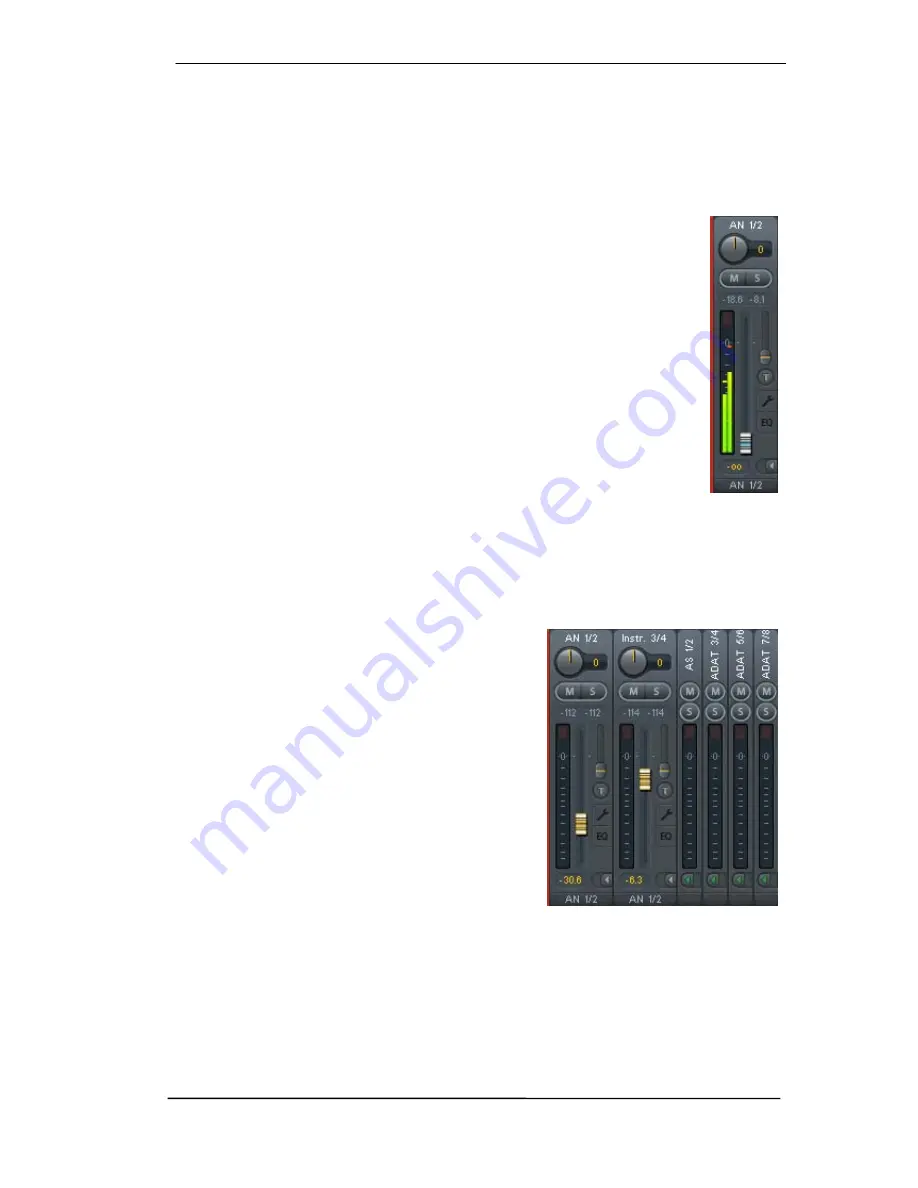
User's Guide Babyface Pro
© RME
43
21.3 The Channels
A single channel can be switched between mono and stereo mode. The mode is set in the
channel settings.
Channel name.
The name field is the preferred place to select a channel by a mouse click. A
double click opens a dialog to assign a different name. The original name will be shown when
activating the option
Names
in the View Options.
Panorama.
Routes the input signal freely to the left and right routing destination
(lower label, see below). The level reduction in center position is -3 dB.
Mute and Solo.
Input channels and playback channels each have a mute and
solo button.
Numerical level display.
Shows the current RMS or Peak level, updated twice
per second. OVR means overload. The setting Peak/RMS is changed in the View
Options.
Level meter.
The meter shows both peak values (zero attack, 1 sample is enough
for a full scale display) by means of a yellow line, and mathematically correct RMS
values by means of a green bar. The RMS display has a relatively slow time con-
stant, so that it shows the average loudness quite well. Overs are shown in red at
the top of the bar. In the Preferences dialog (F2) the Peak Hold time, the over
detection and the RMS reference can be set.
Fader.
Determines the gain/level of the signal routed to the current routing destination (lower
label). Please note that this fader is not
the
fader of the channel, but only the fader of the cur-
rent routing. Compared to a standard mixing desk TotalMix does not have a channel fader, but
only Aux Sends, as many as there are hardware outputs. Therefore TotalMix can create as
many different Submixes as there are hardware outputs. This concept is understood best in the
Submix View, but more on that later.
Below the fader the
Gain
is shown in a numerical
display field, according to the current fader position. The
fader can be:
¾
dragged with the left mouse button pressed
¾
moved by the mouse wheel
¾
set to 0 dB and
−∞
by a double click. The same
happens with a single click plus held down Ctrl key.
¾
adjusted in fine mode by mouse drag and mouse
wheel when holding the Shift key down
A Shift-click on a fader adds the fader to the
temporary
fader group
. All faders now marked yellow are ganged,
and move simultaneously in a relative way. The
temporary fader group is deleted by a click on the F
symbol in the upper right of the window.
The
arrow symbol
at the bottom minimizes the channel width to that of the level meters. An-
other click maximizes it again. A mouse click with held Ctrl key causes all channels to the right
to enlarge and minimize at once.
Содержание Babyface Pro
Страница 5: ...User s Guide Babyface Pro RME 5 User s Guide Babyface Pro General...
Страница 11: ...User s Guide Babyface Pro RME 11 User s Guide Babyface Pro Installation and Operation Windows...
Страница 28: ...28 User s Guide Babyface Pro RME...
Страница 29: ...User s Guide Babyface Pro RME 29 User s Guide Babyface Pro Installation and Operation Mac OS X...
Страница 38: ...38 User s Guide Babyface Pro RME...
Страница 39: ...User s Guide Babyface Pro RME 39 User s Guide Babyface Pro TotalMix FX...
Страница 41: ...User s Guide Babyface Pro RME 41...
Страница 73: ...User s Guide Babyface Pro RME 73 User s Guide Babyface Pro Technical Reference...
Страница 81: ...User s Guide Babyface Pro RME 81 27 Diagrams 27 1 Block Diagram Babyface Pro...
Страница 83: ...User s Guide Babyface Pro RME 83 User s Guide Babyface Pro Stand Alone and Class Compliant Mode...
Страница 91: ...User s Guide Babyface Pro RME 91 User s Guide Babyface Pro Miscellaneous...






























